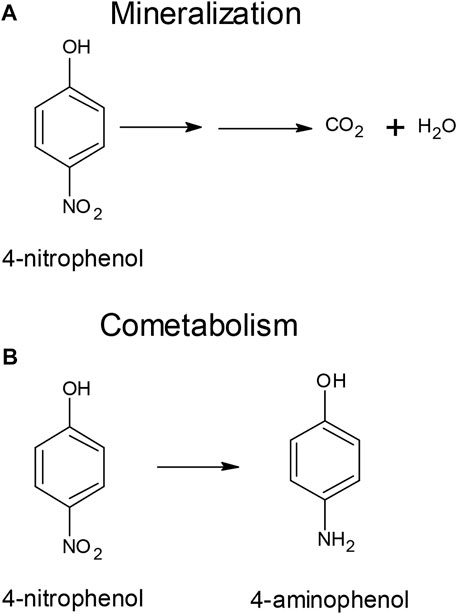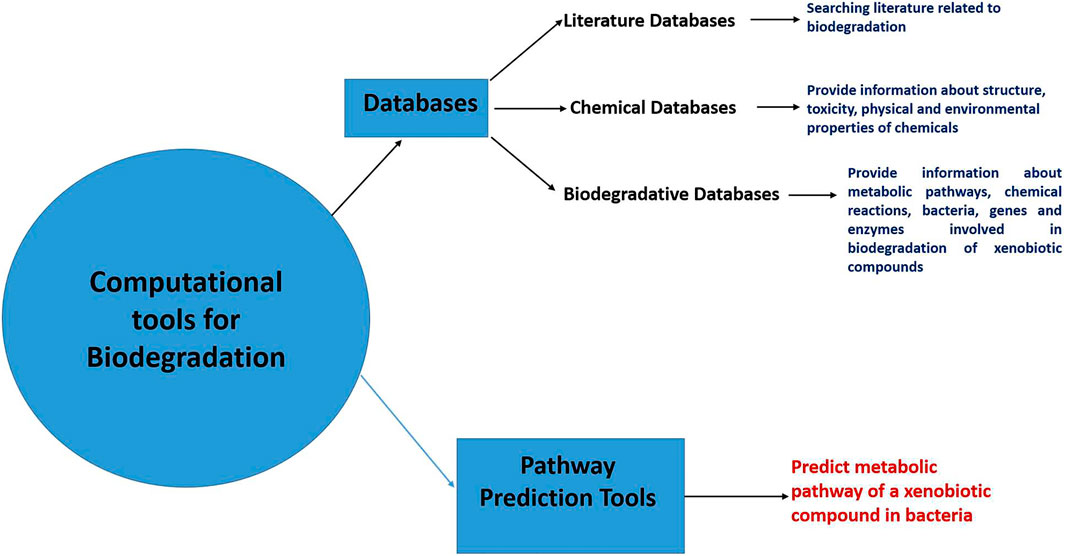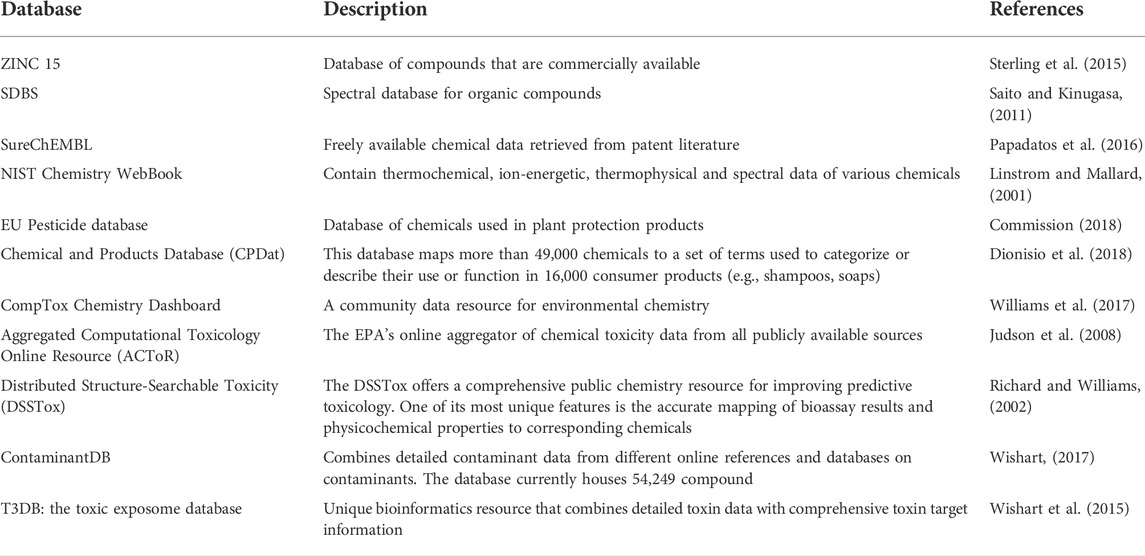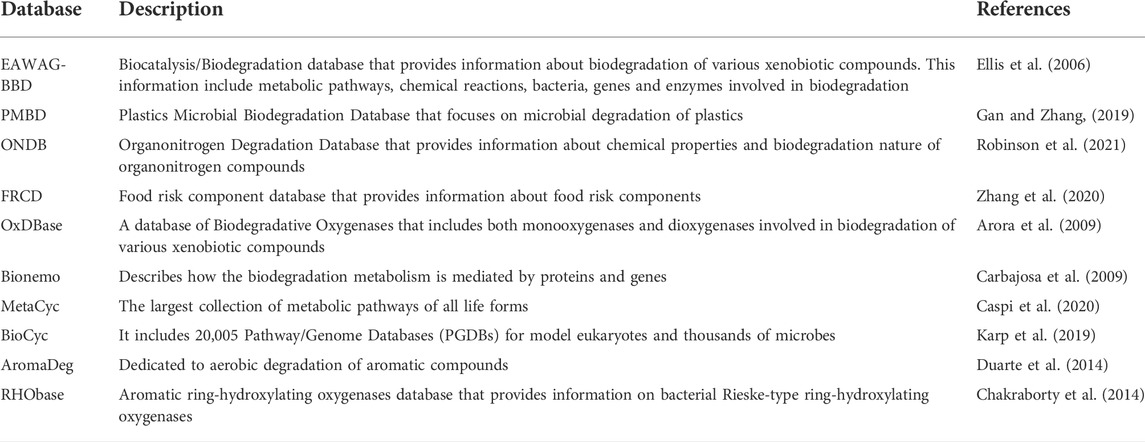- 1Department of Environmental Microbiology, Babasaheb Bhimrao Ambedkar University, Lucknow, India
- 2Department of Plant Science, Faculty of Applied Sciences, MJP Rohilkhand University, Bareilly, India
The review summarizes different bioinformatics tools used in studying the degradation of various xenobiotic compounds. Databases and Pathway Prediction Systems are the key bioinformatics tools involved in biodegradation. Several bio-degradative databases including EAWAG-BBD (Biocatalysis/Biodegradation Database), Plastics Microbial Biodegradation Database, ONDB (Organonitrogen Degradation Database), Food risk component database (Food risk component database, Aromadeg (Aromatic hydrocarbon Degrading Database), OxDBase (A database of Biodegradative oxygenases), and RHObase database (ring-hydroxylating oxygenase database) have been developed for biodegradation and bioremediation studies. Users can use pathway prediction systems to predict degradation of xenobiotic whose degradation has never been reported in the literature. This review will help to design a strategy for biodegradation of chemicals therefore, also help in improved bioremediation process of chemicals.
1 Introduction
Biodegradation and Bioinformatics are two fundamental areas of environmental sciences and biotechnology. Biodegradation is a process of microbes-mediated breakdown of various toxic chemicals and other xenobiotic compounds (Arora et al., 2012). Microbes degrade toxic chemicals through the process of mineralization or co-metabolism. During the mineralization process, microbes use toxic molecules as their food materials to gain carbon, and energy and completely utilized them via enzymatic reactions. However, co-metabolism is a process by which biochemical reactions convert toxic compounds into less toxic ones. Figure 1 illustrates the bacterial mineralization and cometabolism of 4-nitrophenol. Mineralization of 4-nitrophenol results in carbon dioxide and water, which are utilized by bacteria to gain energy. In contrast, 4-nitrophenol cometabolized into 4-aminophenol, which was not utilized by bacteria. A toxic chemical can only be degraded by a specific microbe that is responsive to the chemical’s structure and the enzymes present in that microbe to tackle that specific chemical.
Microbial remediation has emerged as a technology aimed at removing hazardous materials from our soil and water. Many microbes have been identified that have ability for the removal of xenobiotic substances from the environment. Several microbial enzymes including hydrolases, dehalogenases, dioxygenases and monooxygenase are directly involved in biodegradation process. Bioremediation can now be enhanced by cloning the genes encoding these enzymes into bacteria.
Bioremediation can be improved by having knowledge about various xenobiotic compounds and their biodegradation (Arora and Bae, 2014). Due to the integration of bioinformatics and biodegradation, many bioinformatic tools have been developed to determine the fate of xenobiotic compounds in environment as well as to understand their degradation mechanism (Arora et al., 2009; Ellis et al., 2006: Gan and Zhang, 2019) Databases and Pathway Prediction tools are more prominent examples of these tools. An overview of various databases and pathways prediction tools can be found in Figure 2. This article summarizes the various databases and pathway prediction tools used in biodegradation studies.
2 Databases
Literature databases, Chemical databases, Biodegradative Databases are examples of these tools. Literature databases contain a collection of research publications and review articles related to various fields of sciences. SCOPUS and PubMed are the two literature databases. Users can search papers related to biodegradation and bioremediation using these databases.
Chemical databases store information about structure, toxicity, physical and environmental properties of chemicals. PubChem is the largest database of the world that offers free access 8to chemical research information. Chemicals can be searched by name, structure, molecular formula, and other criteria. Information on chemical and physical properties, biological activities, safety and toxicity, literature citations and patents can be found here. Other environmentally important chemical databases are summarizing in Table 1
2.1 Biodegradative databases
Biodegradative databases are those databases, which store the information primarily on biodegradation of various xenobiotic compounds. Examples are EAWAG-BBD (Biocatalysis/Biodegradation Database), PMBD (Plastics Microbial Biodegradation Database), ONDB (Organonitrogen Degradation Database), FRCD (Food risk component database), Aromadeg (Aromatic hydrocarbon Degrading Database), OxDBase (A database of Biodegradative oxygenases), RHObase database (ring-hydroxylating oxygenase database). Table 2 provides a list of bio-degradative databases.
EAWAG-BBD was the first well-maintained database dedicated to biodegradation and bioremediation, initially maintained by the University of Minnesota and currently is running by the EAWAG. Using this database, users can get information of metabolic degradation pathways of a wide range of xenobiotic compounds (Ellis et al., 2006). Various fields of interests including microbes (543), bio-transforming rules (250), genes, proteins 993) metabolic pathways 219) and chemical reactions (1503) that contribute to the decomposition of xenobiotic compounds are included in this database.
Another database, OxDBase, was developed by Chandigarh, India’s CSIR-Institute of Microbial Technology and freely available at http://www.imtech.res.in/raghava/oxdbase. OxDBase is an information-storage database that provides details of monooxygenases and dioxygenases involved in the aerobic degradation of various aromatic compounds (Arora et al., 2009).
PMBD (http://pmbd.genome-mining.cn/home) is dedicated to microbial degradation of plastics and contained information about 949 microorganisms-plastic degradation relationships and 79 genes involved in microbial degradation of plastics (Gan and Zhang, 2019). In addition, information of 8000 predicted sequences of the enzymes involved in plastic biodegradation are also provided in this database.
ONDB includes information on chemical properties and biodegradability of commonly used organonitrogen compounds (Robinson et al., 2021). It provides insight into the pathways, reactions, microbes, and enzymatic reactions associated with degradation of organonitrogen compounds including urea, methylenediurea, Guanyl thiourea (1-amidino-2-thiourea, GTU), cyanuric acid, Cyanoguanidine, biuret (carbamoylurea), Allophanate.
FRCD ((http://www.rxnfinder.org/frcd/) is dedicated to food risk components which may be defined as chemicals which are present in foods and create problems to human health if they consume (Zhang et al., 2020). Examples of these compounds are toxic metals, pesticides, microbial metabolites and food additives. This database contains information of 12,018 toxic molecules from more than 150,,000 literature reports. Apart of the toxicity and biodegradability of these compounds, FRCD also provides data on molecular scaffold and chemical diversity of these compounds.
AromaDeg (http://aromadeg.siona.helmholtz-hzi.de) is a freely accesses web-based database that focuses on aerobic degradation of aromatic compounds. This database develops based on phylogenomic approach (Duarte et al., 2014). Through AromaDeg, it is possible to attempt to identify the amino acid sequences of key aerobic aromatic degradation enzyme families by querying novel genomic, metagenomic, or metatranscriptomic data sets. In initial step, each query sequence that belongs to one of the protein families considered in AromaDeg is aligned with other members of the respective protein family and thereby grouped in a specific cluster on the phylogenetic tree. In next step, functional annotation with substrate specificity can be determined based on experimentally validated functions of neighbouring cluster members. In this way, AromaDeg provides not only a comprehensive characterization of each protein superfamily but also high-throughput functional classifications of protein. This approach overcomes the limitations of homology-based function prediction and results in more accurate annotations of new biological functions associated with aerobic degradation pathways of aromatic compounds.
Bionemo (http://bionemo.bioinfo.cnio.es) is a manually curated database that was created by structural computational biology researchers at the Spanish National Cancer Research Center (Carbajosa et al., 2009). It contains information about the proteins and genes responsible for the metabolic process of biodegradation. There are 145 biochemical pathways, 945 reactions - 342 which have complexes associated with them, 537 enzymatic complexes, 1107 proteins, 234 microbial species, 90 transcription factors, 90 effectors, 128 TF DNA binding sites, and 100 promoters in this database.
MetaCyc contains information more than 2937 experimentally verified metabolic pathways from more than 3295 different organisms, which have been derived from experimental literature (Caspi et al., 2020). MetaCyc is the largest database that provide information about primary and secondary metabolic pathways as well as associated compounds, enzymes and genes. The database can be accessed for free at http://metacyc.org. MetaCyc is applicable to a variety of scientific fields. Additionally, it can serve as a database of reference data for computations of metabolic pathways by using sequenced genomes, (i) support metabolic engineering, (iii) facilitate comparisons of biochemical networks, and (iv) serve as a repository of metabolic knowledge from genomes. BioCyc group at SRI International developed and curated this database.
3 Pathway prediction systems
The ability to predict metabolic and degradation pathways of xenobiotics has great interest in the field of environmental sciences. Many researchers have developed bioinformatics-based pathway prediction systems that use knowledge-based models, machine learning algorithms, or a hybrid approach. Both knowledge based and machine learning methods have disadvantages due to their dependency on existing data or transformation rules based on the available literature. Combining knowledge- and machine learning-based approaches, hybrid methods use machine learning-based relative reasoning models in order to predict the chances of individual transformation reactions. Example are BNICE (Biochemical Network Integrated Computational Explorer), and EAWAG-Pathway Prediction System (PPS).
BNICE is a computational prediction tool that produces all reactions of compounds know so far (Finley et al., 2009). This program uses enzyme reaction rules derived from the enzyme commission (EC) classification system. To predict a metabolic pathway, BNIC first identified functional group present in parent compounds then produces related compounds based on reaction rules. Each product undergoes this process until pathway is complete.
In EAWAG-PPS, pathway prediction is performed by identifying the functional chemical groups in a starting compound, and then determining the transformed product based on biotransformation rules (Gao et al., 2011)
4 Conclusion and future prospective
The biodegradation of chemicals is described in several databases. Users can use various databases to gain information about chemicals and their degradation. The biodegradative databases can be used to retrieve information about bacterial degradation of xenobiotic compounds including associated genes and enzymes. Similarly, using chemical databases, users can retrieve information about various properties of chemicals including their risk assessment and environmental properties. There are also several pathway prediction systems that can be used to predict degradation pathways for chemicals whose degradation pathways are unknown. Users can predict metabolic pathway of the compounds using various pathway prediction systems. These information will help to design a strategy for biodegradation of chemicals therefore, also help in improved bioremediation process of chemicals.
Author contributions
All authors listed have made a substantial, direct, and intellectual contribution to the work and approved it for publication.
Acknowledgments
The author acknowledges the Department of Biotechnology, India to provide him Ramalingaswami Re-entry Fellowship.
Conflict of interest
The authors declare that the research was conducted in the absence of any commercial or financial relationships that could be construed as a potential conflict of interest.
Publisher’s note
All claims expressed in this article are solely those of the authors and do not necessarily represent those of their affiliated organizations, or those of the publisher, the editors and the reviewers. Any product that may be evaluated in this article, or claim that may be made by its manufacturer, is not guaranteed or endorsed by the publisher.
References
Arora, P. K., and Bae, H. (2014). Integration of bioinformatics to biodegradation. Biol. Proced. Online 16 (1), 8–10. doi:10.1186/1480-9222-16-8
Arora, P. K., Kumar, M., Chauhan, A., Raghava, G. P., and Jain, R. K. (2009). OxDBase: A database of oxygenases involved in biodegradation. BMC Res. Notes 2 (1), 67–68. doi:10.1186/1756-0500-2-67
Arora, P. K., Sasikala, C., and Ramana, C. (2012). Degradation of chlorinated nitroaromatic compounds. Appl. Microbiol. Biotechnol. 93 (6), 2265–2277. doi:10.1007/s00253-012-3927-1
Carbajosa, G., Trigo, A., Valencia, A., and Cases, I. (2009). Bionemo: Molecular information on biodegradation metabolism. Nucleic Acids Res. 37 (1), D598–D602. doi:10.1093/nar/gkn864
Caspi, R., Billington, R., Keseler, I. M., Kothari, A., Krummenacker, M., Midford, P. E., et al. (2020). The MetaCyc database of metabolic pathways and enzymes - a 2019 update. Nucleic Acids Res. 48 (D1), D445–D453. doi:10.1093/nar/gkz862
Chakraborty, J., Jana, T., Saha, S., and Dutta, T. K. (2014). Ring‐hydroxylating oxygenase database: A database of bacterial aromatic ring‐hydroxylating oxygenases in the management of bioremediation and biocatalysis of aromaticcompounds. Environ. Microbiol. Rep. 6 (5), 519–523. doi:10.1111/1758-2229.12182
Commission (2018). Regulation (EC) No 396/2005 : EU pesticide database. Available online: http://ec.europa.eu/food/plant/pesticides/eu-pesticides-database/public/?event=pesticide.residue.CurrentMRLandlanguage=EN.
Dionisio, K. L., Phillips, K., Price, P. S., Grulke, C. M., Williams, A., Biryol, D., et al. (2018). The Chemical and Products Database, a resource for exposure-relevant data on chemicals in consumer products. Sci. Data 5 (1), 180125–180129. doi:10.1038/sdata.2018.125
Duarte, M., Jauregui, R., Vilchez-Vargas, R., Junca, H., and Pieper, D. H. (2014). AromaDeg, a novel database for phylogenomics of aerobic bacterial degradation of aromatics. Database 2014, bau118. doi:10.1093/database/bau118
Ellis, L. B., Roe, D., and Wackett, L. P. (2006). The university of Minnesota biocatalysis/biodegradation database: The first decade. Nucleic Acids Res. 34 (1), D517–D521. doi:10.1093/nar/gkj076
Finley, S. D., Broadbelt, L. J., and Hatzimanikatis, V. (2009). Computational framework for predictive biodegradation. Biotechnol. Bioeng. 104 (6), 1086–1097. doi:10.1002/bit.22489
Gan, Z., and Zhang, H. (2019). Pmbd: A comprehensive plastics microbial biodegradation database. Database 2019, baz199. doi:10.1093/database/baz119
Gao, J., Ellis, L. B., and Wackett, L. P. (2011). The university of Minnesota pathway prediction system: Multi-level prediction and visualization. Nucleic Acids Res. 39 (2), W406–W411. doi:10.1093/nar/gkr200
Judson, R., Richard, A., Dix, D., Houck, K., Elloumi, F., Martin, M., et al. (2008). ACToR—Aggregated computational toxicology resource. Toxicol. Appl. Pharmacol. 233 (1), 7–13. doi:10.1016/j.taap.2007.12.037
Karp, P. D., Billington, R., Caspi, R., Fulcher, C. A., Latendresse, M., Kothari, A., et al. (2019). The BioCyc collection of microbial genomes and metabolic pathways. Brief. Bioinform. 20 (4), 1085–1093. doi:10.1093/bib/bbx085
Linstrom, P. J., and Mallard, W. G. (2001). The nist chemistry WebBook: A chemical data resource on the internet. J. Chem. Eng. Data 46 (5), 1059–1063. doi:10.1021/je000236i
Papadatos, G., Davies, M., Dedman, N., Chambers, J., Gaulton, A., Siddle, J., et al. (2016). SureChEMBL: A large-scale, chemically annotated patent document database. Nucleic Acids Res. 44 (1), D1220–D1228. doi:10.1093/nar/gkv1253
Richard, A. M., and Williams, C. R. (2002). Distributed structure-searchable toxicity (DSSTox) public database network: A proposal. Mutat. Research/Fundamental Mol. Mech. Mutagen. 499 (1), 27–52. doi:10.1016/s0027-5107(01)00289-5
Robinson, S. L., Biernath, T., Rosenthal, C., Young, D., Wackett, L. P., and Martinez-Vaz, B. M. (2021). Development of the organonitrogen biodegradation database: Teaching bioinformatics and collaborative skills to undergraduates during a pandemic. J. Microbiol. Biol. Educ. 22 (1), 22.1.49–2351. doi:10.1128/jmbe.v22i1.2351
Saito, T., and Kinugasa, S. (2011). Development and release of a spectral database for organic compounds. Synth. Engl. Ed. 4 (1), 35–44. doi:10.5571/syntheng.4.35
Sterling, T., and Irwin, J. J. (2015). ZINC 15–ligand discovery for everyone. J. Chem. Inf. Model. 55 (11), 2324–2337. doi:10.1021/acs.jcim.5b00559
Williams, A. J., Grulke, C. M., Edwards, J., McEachran, A. D., Mansouri, K., Baker, N. C., et al. (2017). The CompTox chemistry dashboard: A community data resource for environmental chemistry. J. Cheminform. 9 (1), 61–27. doi:10.1186/s13321-017-0247-6
Wishart, D., Arndt, D., Pon, A., Sajed, T., Guo, A. C., Djoumbou, Y., et al. (2015). T3DB: The toxic exposome database. Nucleic Acids Res. 43 (D1), D928–D934. doi:10.1093/nar/gku1004
Wishart, D. S. (2017). ContaminantDB. http://contaminantdb.ca.
Keywords: biodegradation, bioinformatics, database, pathway prediction system, EAWAG-BBD, scopus
Citation: Arora PK, Kumar A, Srivastava A, Garg SK and Singh VP (2022) Current bioinformatics tools for biodegradation of xenobiotic compounds. Front. Environ. Sci. 10:980284. doi: 10.3389/fenvs.2022.980284
Received: 29 June 2022; Accepted: 05 August 2022;
Published: 26 August 2022.
Edited by:
Joginder Singh, Lovely Professional University, IndiaReviewed by:
Vineet Kumar, National Environmental Engineering Research Institute (CSIR), IndiaShweta Jaiswal, Maharshi Dayanand University, India
Hanuman Singh Jatav, Sri Karan Narendra Agriculture University, India
Copyright © 2022 Arora, Kumar, Srivastava, Garg and Singh. This is an open-access article distributed under the terms of the Creative Commons Attribution License (CC BY). The use, distribution or reproduction in other forums is permitted, provided the original author(s) and the copyright owner(s) are credited and that the original publication in this journal is cited, in accordance with accepted academic practice. No use, distribution or reproduction is permitted which does not comply with these terms.
*Correspondence: Pankaj Kumar Arora, YXJvcmE0ODRAZ21haWwuY29t
 Pankaj Kumar Arora
Pankaj Kumar Arora Ashish Kumar
Ashish Kumar Alok Srivastava2
Alok Srivastava2


